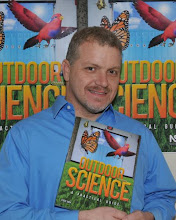In the existing
literature relating science achievement to outdoor learning, one study (Cronin-Jones,
2000) stands out as the one that most closely matches my proposed research. Though
slightly dated, it is the only available study that has directly tackled this specific
topic. The following summarizes this significant work.
Research
Questions
1.
Do elementary students receiving outdoor schoolyard-based
instruction learn more about basic ecological concepts than students receiving
no formal instruction or traditional classroom-based instruction?
2.
Do elementary students receiving outdoor schoolyard-based
instruction develop more positive attitudes toward natural settings and their
inhabitants than students receiving no formal instruction or traditional
classroom-based instruction?
Theoretical
Perspective
The perspective
of this study is unique in that it does not adhere to an overarching well-known
educational theory. The researcher considers a variety of works by those who
have studied teaching outdoors and acknowledges that there was at the time a
limited body of knowledge on this area of education. This study examined both
achievement and how student attitudes toward learning outdoors may have
changed.
Research
Paradigm
This study was
conducted prior to the most well-known, if not the most significant work in
this field was published (Louv, 2005). It broke new ground for science teachers
and environmental educators. Though solid suggestions for future research were
presented, few if any are found in a review of literature from the time of this
study until present day. Perhaps my proposed study will take a step in that
direction and encourage others to add to this field of research.
Specific
Methodology
Two third grade
and two fourth grade classes at two schools participated in this study. Students
took a pre-test that with analysis through a modified Solomon Four Group
design. Though students were not randomly assigned to the study, they were
randomly assigned to their classes at the beginning of the school year. The two
schools involved have very similar demographics for ethnicity, gender, and
socio-economic status. It is not clear to me as to why two of the four classes
completed both pretests and posttests and the other two completed only
posttests. However there is some reference to the effect of the pretests, so
perhaps the researcher was concerned that a pretest may in some way influence
student achievement on the subsequent posttests.
Findings
This study provided some evidence that schoolyards can serve
as an effective setting for teaching science. The researcher found evidence
that student achievement was positively impacted when a 10-day unit of study
was conducted outdoors as compared to the same unit taught indoors.
Conclusions
The study
concludes that teaching science in the schoolyard can have a positive impact on
student achievement. There was a significant gain on posttests that used
reliable test items. However, there was no significant gain in a positive attitude
toward outdoor learning. Any differences were very minor when comparing the
initial survey to the final survey.
How
does this research relate to yours?
This study
aligns very closely with the study I have proposed in both content and
methodology. Like this study, mine will be conducted at the elementary school
level, and will measure the difference in student achievement in science when
an environmental standard is taught outdoors instead of indoors. As the work
with my chair continues, I am curious as to how closely aligned the two studies
are and if my study is very nearly a replication of this one.
What
are your impressions of the project?
This study was
ground breaking at the time it was conducted, and remains significant today. As
such, I am impressed by the researcher’s recognition of the need for this
study. At the end of the study there are good suggestions for future research.
It is surprising that little evidence can be found in related literature to
suggest any of these ideas have been studied in the years since. In this study,
only a few classrooms were involved, and that has impressed upon me that
multiple small-scale studies regarding this topic would be more significant
perhaps than one large scale study.
Bibliography
Cronin-Jones, L. (2000).
The effectiveness of schoolyards as sites for elementary science
instruction.
School Science & Mathematics, 100, 203-212.
Louv, R. (2005).
Last child in the woods,
Chapel Hill, N.C., Algonquin Books.

No comments:
Post a Comment